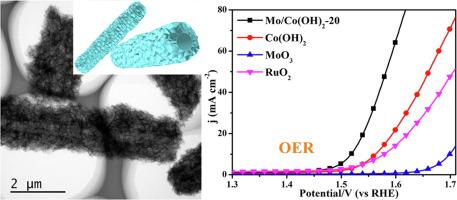当前位置:
X-MOL 学术
›
J. Colloid Interface Sci.
›
论文详情
Our official English website, www.x-mol.net, welcomes your
feedback! (Note: you will need to create a separate account there.)
Structural engineering and electronic state tuning optimization of molybdenum-doped cobalt hydroxide nanosheet self-assembled hierarchical microtubules for efficient electrocatalytic oxygen evolution
Journal of Colloid and Interface Science ( IF 9.4 ) Pub Date : 2022-08-17 , DOI: 10.1016/j.jcis.2022.08.069
Chao Wang 1 , Wen Li 1 , Andrey A Kistanov 2 , Harishchandra Singh 2 , Yves Kayser 3 , Wei Cao 2 , Baoyou Geng 4
Journal of Colloid and Interface Science ( IF 9.4 ) Pub Date : 2022-08-17 , DOI: 10.1016/j.jcis.2022.08.069
Chao Wang 1 , Wen Li 1 , Andrey A Kistanov 2 , Harishchandra Singh 2 , Yves Kayser 3 , Wei Cao 2 , Baoyou Geng 4
Affiliation

|
Cobalt-based hydroxide are ideal candidates for the oxygen evolution reaction. Herein, we use molybdenum oxide nanorods as sacrificial templates to construct a self-supporting molybdenum-doped cobalt hydroxide nanosheet hierarchical microtubule structure based on a structural engineering strategy to improve the active area of the catalyst. X-ray-based spectroscopic tests revealed that Mo (VI) with tetrahedral coordination intercalated into the interlayer of cobalt hydroxide, promoting interlayer separation. At the same time, Mo is connected with Co through oxygen bonds, which promotes the transfer of Co charges to Mo and reduces the electron cloud density of Co ions. In 1 M KOH, optimized molybdenum-doped cobalt hydroxide nanosheet microtubules only needs an overpotential of 288 mV to drive a current density of 10 mA cm, which is significantly better than that of pure Co(OH) nanosheets and RuO. Structural engineering and electronic state regulation can effectively improve the oxygen evolution activity of cobalt-based hydroxide, which provides a design idea for the development of efficient oxygen evolution catalysts.
中文翻译:

钼掺杂氢氧化钴纳米片自组装分层微管的结构工程和电子态调谐优化,用于高效电催化析氧
钴基氢氧化物是析氧反应的理想选择。在此,我们使用氧化钼纳米棒作为牺牲模板,基于结构工程策略构建了自支撑钼掺杂氢氧化钴纳米片分级微管结构,以提高催化剂的活性面积。 X射线光谱测试表明,具有四面体配位的Mo(VI)嵌入到氢氧化钴的层间,促进层间分离。同时,Mo与Co通过氧键连接,促进Co电荷向Mo的转移,降低Co离子的电子云密度。在1 M KOH中,优化的钼掺杂氢氧化钴纳米片微管仅需要288 mV的过电位即可驱动10 mA cm的电流密度,明显优于纯Co(OH)纳米片和RuO。结构工程和电子态调控可以有效提高钴基氢氧化物的析氧活性,这为开发高效析氧催化剂提供了设计思路。
更新日期:2022-08-17
中文翻译:

钼掺杂氢氧化钴纳米片自组装分层微管的结构工程和电子态调谐优化,用于高效电催化析氧
钴基氢氧化物是析氧反应的理想选择。在此,我们使用氧化钼纳米棒作为牺牲模板,基于结构工程策略构建了自支撑钼掺杂氢氧化钴纳米片分级微管结构,以提高催化剂的活性面积。 X射线光谱测试表明,具有四面体配位的Mo(VI)嵌入到氢氧化钴的层间,促进层间分离。同时,Mo与Co通过氧键连接,促进Co电荷向Mo的转移,降低Co离子的电子云密度。在1 M KOH中,优化的钼掺杂氢氧化钴纳米片微管仅需要288 mV的过电位即可驱动10 mA cm的电流密度,明显优于纯Co(OH)纳米片和RuO。结构工程和电子态调控可以有效提高钴基氢氧化物的析氧活性,这为开发高效析氧催化剂提供了设计思路。

































 京公网安备 11010802027423号
京公网安备 11010802027423号